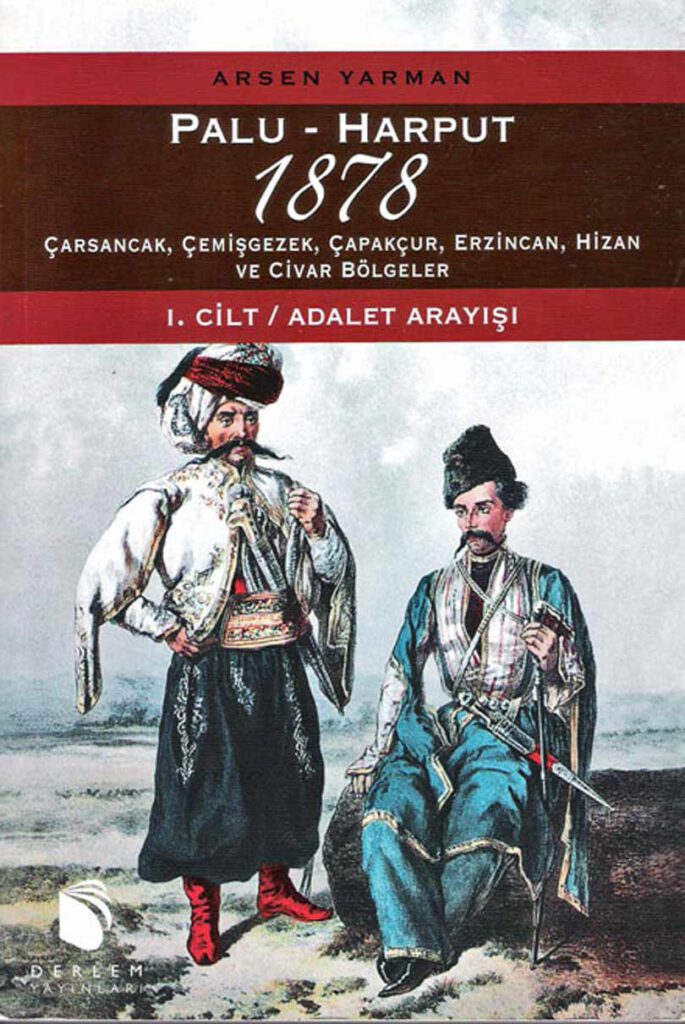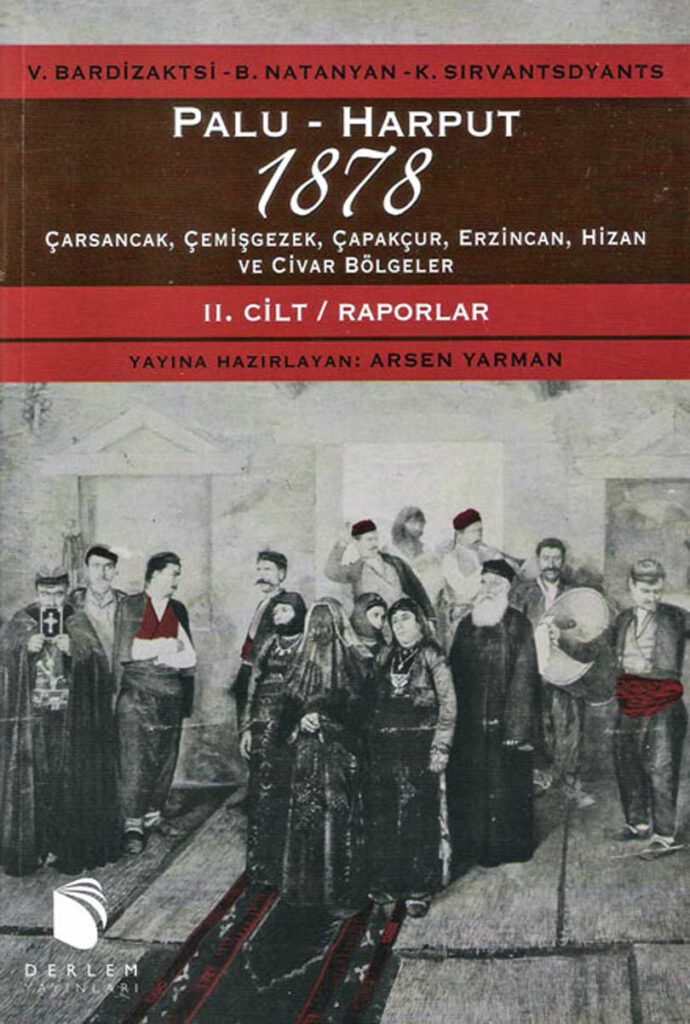Arsen Yarman, in his recent comprehensive study[1], focuses on the war zones of the Empire after the Russo-Turkish War and the situation of the Armenians living in a geography trodden by fifty years of battle. His point of departure is the book of Boğos Natanyan querying for justice, titled Armenia’s Tears and Misery and the reports of priests (Servantsiants and Minassian) sent to the region with Ottomans’ knowledge and approval to establish the situation in the armenian provinces, as regards the reforms to apply in accordance with article 61 of the Treaty of Berlin signed following the Russo-Turkish War of 1877–1878, and priest Boğos Natanyan sent to Palu on the same date and entrusted with the same task for two years. Although several historians mention the Russo-Turkish War, a period playing a crucial role in the destiny of the Empire is examined for the first time, offering such a wide projection. We admit, Yarman has added an important note to history. The related study is supported with many original reports and documents together with the reports of the religious authors.
The first volume of Yarman’s study, Quest for Justice, can be read as a comprehensive treatise of historical sociology. The said volume examines the breaking and the new inclination experienced by the Ottoman Empire following the Russo-Turkish War of 1877–1878, together with the actors of the relevant period. Besides, Yarman compares within the same period the reports written by the priests after mere examinations while the iron was hot, with the ones issued by foreign observers present in the region under the permission of Ottoman authorities. Yarman’s study, from that point of view, is offering for the first time an inclusive review atsucha largescale, pertaining to postwar situation of the Ottomans.
While pointing out the fateful characteristic of the year 1878 for the Empire; apart the wide geography and the Ottoman Armenians, the study reflects the unique anatolian mosaic by shedding light onto the history of several populations like the Russian Armenians, the Iranian Armenians, the Armenians converted to Islam, the Turks, the Chaldeans, the Nestorians, the Armenized Greeks, the Romanized Armenians, the Muslims speaking Armenian, the Laz, the Hemshinli, the Greeks, the Kurdish Armenians, the Kurds, the Kurds speaking Armenian, the Armenians speaking Kurdish, the Zazas, the Armenians speaking Zazaki, the Assyrians, the Yazidi, the Jews, the Bosha, the Karapapakh, the Persians, the Tatars, the Circassians, the worshipers of sun, the Arevortik , the Sevorti, the Alevi, the Qizilbash, the Dimilis, the Gesges, the Christians. Facts like Mullahs, Sheikhs, Meliks, Sayyids, Clans, Beys, Agas, Bands, Priests, Clericals are also taken into consideration and examined with accuracy. Let us also affirm; many readers who take part in the other ethnic elements beside Armenians: Turks, Kurds, Circassians…while encountering their unknown history in this study, would find it through another perspective.

The year 1878 is the breaking point of the Empire, the date of its evolution towards a new direction. The beginning of Hamidian era which will end by the disintegration of the Empire following the said direction. We can say that this date is also a turning point for Turks, Armenians, Kurds living in the East of the Empire and Circassians who finally took part as ethnic actors in the region with the Russo-Turkish War. In Arsen Yarman’s projection all those actors are examined together in order to elaborate a historical and social analyse pertaining to the relevant period. Therefore we have to say, a treatise focuses for the first time with integrity on the social relations of all the actors in the region. Not content with the perspective of local actors only, foreign actors are also taken into consideration and political preferences of active empires like United Kingdom and Russia rivalling in the region are made clear to give an idea to the reader as to how the destiny of the ottoman populations is influenced. Apart, the studied territory represents a vast anatolian geography.
The region is examined through several perspectives as it represents a geography mostly afflicted by the war. Besides, the ethnic variety makes it a territory of special importance. New actors, the Circassians are added to the autochthon peoples of the region for the first time since 1071. The region becomes the stage of large-scale populationmovements before and after the war. The year 1878 represents an important turning point for Kurds and Armenians as well. Among the Kurds finding a place for themselves in the new centralization project, the idea of independence began to appear by the insurrection of Sheikh Oubaidallah. The reports of clerical authors included in the book proves as versatile as Arsen Yarman’s study.
Yarman hem bu raporların hem de yabancı görevlilerin raporlarının dönemin anlaşılması bakımından öneminin altını çizer “Natanyan’ın ve diğer rahiplerin raporları sadece Ermeni toplumuna ilişkin değillerdir, rahipler inceleme yaptıkları bölgenin ayrıntılı bir etnik ve kültürel haritasını çıkarmışlardı.
Yarman underlines the importance of both these and the foreign functionaries’ reports to understand the related period: “Natanyan’s and the other priests’ reports do not pertain to Armenian people only; the priests had described a detailed ethnic and cultural map of the region, based on which we analysed the said period through a wide projection regarding before and after 1878 which we can treat as the breaking point of the Empire, together with the relevant geography and beyond the historical situation of the Armenian people. I would share here with readers an interesting observation of mine: like Natanyan’s report concords with the ones of other priests, it proves being in harmony with foreign observers’ reports too. It is useful to add that these observers are acting under the permission of the Sultan. They remit their reports to the Sultan and other functionaries within the frame of the Berlin Treaty as they give them to their chiefs of mission. We understand that the military consuls are not only concerned with the pressures faced by non-muslim population but also consider the demands of muslim people in this regard, consequently they get as much respect from the muslims as they get from the non-muslims. The period where the most intense complaints are expressed is also the period of the highest expectation of reforms. The number of reports printed for in-service use, solely among the reports prepared by military consuls within the second half of 1880, is 220. The principal populations whose situations are looked after are the Armenians, the Kurds, the Abazins, the Laz. Trabzon comes first in the ranking of provinces subject to reports; it is followed by the provinces of Sivas, Van, Diyarbakır, Ankara and the sanjak of İzmit.”

The treatise underlines 1878 as being the year where the Sultan plays on many circles disappointed by Tanzimat and elaborate the direction followed by the new development. The new legitimacy ground of the new period will be based on strengthening only the idea of solidarity concerning the muslims and the exclusion of Christians. This politics defined as official nationalism is an applicationof national patterns by governing dynasties of ethnic empires ideologically surrounded. Hamid, in the name of ottoman caliphate, within the context of the Empire itself and using its historical colour, tries to give himself a mystic appearance and a new personality and by so doing complies with the said politics. While the Hamidian era uses the key concepts like unity and salvation with a new emphasis and orientation and the muslim people compensates in this new legitimacy ground its disappointement caused by Tanzimat proclaiming the equality of all Ottomans before the law and the artificial pressure of Europe mainly for the improvement of the conditions of the christian population, the excluded elements of the Empire are treated as adversaries and pointed as targets.
The elaborated period is, as Abdulhamid states, a period where a strong belief and a paranoia that the Empire would face the continual hostile molestations of christian world get the upper hand. The environment is surrounded by emenies ready to divide and break into pieces and the situation becomes more and more critical. Such a mood expresses itself very well by Abdulhamid’s words: “By taking Greece and Romania, Europe has cut the legs of the Turkish State, says the Sultan, then we have lost our hands by giving Bulgaria, Serbia and Egypt, and now with propagandas among Armenians they try to get reach of our vital organs and even pluck our intestines off. That means the beginning of wholesale destruction and against which we must protect ourselves with might and main.” Let us affirm that the words of Sultan Hamid overlap the Armenian approach of the periods of Young Turks thus representing a continuation as regards the “solution” of the armenian problem, with no need for any additional word.
We can say that apart bringing to light the books of Natanyan and the other authors, Servantsiants and Minassian, Arsen Yarman filled an important gap treating with integrity all the actors playing a role inside and outside the region at the starting point of Hamidian period where the Empire’s new orientation is being shaped. Besides, by enriching his study with almost 300 photos and post cards as visual materials, he is drawing our attention to the huge culture created by the armenian people in a geography where they no more live today. Therefore we congratulate Arsen Yarman for the important note he added to history, on various aspects.
Sait Çetinoğlu
[1] Arsen Yarman, Palu, Harput, Çarsancak, Çemişkezek, Çapakçur, Erzincan, Kizan, ve Civar Bölgeler 1878, Adalet arayışı, 1. Cilt, Raporlar, 2. Cilt, Derlem Yayınları, 2010.
